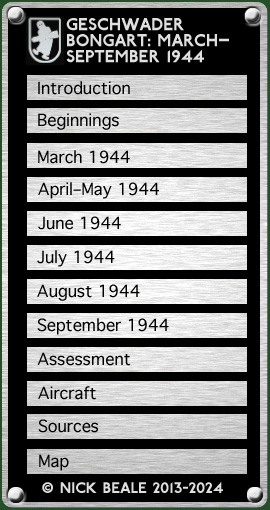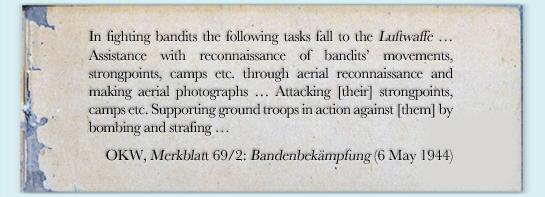|
Between 5 and 13 February the German 157. Reserve Division carried out Aktion Korporal, a push against the Maquis of the Ain Département. The opening day’s attack on the Bugey area (east of the River Ain) was supported by aircraft but the whole operation was curtailed by heavy snowfalls. In March Luftflotte 3 again deployed airpower, in support of Hochsavoyen (Haute-Savoie) an operation by the same division and the Vichy Milice against the Maquis of the Glières Plateau, between Annecy and the Swiss border. When it became clear that the Vichy paramilitaries were making no progress on the ground, the Germans stepped in, although the fiction of an exclusively French undertaking was maintained in the press. As early as 7 February Vichy authorities had called for photo-reconnaissance of the Plateau to locate Maquis encampments with air attacks to follow. In his report on February’s developments, the Lfl. 3 representative in Vichy, Oberst Heinz-Ludwig von Holleben, gave this assessment: Thanks to the energetic measures of General Secretary for the Maintenance of Public Order Darnand there has been an appreciable decline in acts of terror and assassinations. [However] the action in Haute-Savoie where about 5000 bandits are ensconced on a high plateau north east of Annecy has rather bogged down at the moment … the Milice requested … that an aircraft be made available to make photos of the plateau concerned. With Luftflotte 3’s agreement the necessary arrangements were made. A conference took place in Annecy on the 21st, attended by Oberstleutnant Walter Killian, a staff officer with Luftflotte 3 and a recce ensued on 4 March then four days later a lone aircraft was seen to reconnoitre the plateau. Ob. West’s diary for the 10th noted orders for a Kette of three aircraft be held at constant readiness in Dijon for “immediate employment following terrorist attacks and against terrorist camps.” These were amplified in a message to Military Commander France and Luftflotte 3: 10.3.44, 19.00 hrs. Re: Combating Bandits On orders from Lfi.Kdo. 3, IV./KG 55 in Dijon (He 111) is to hold a Kette (3 machines) available for Ob. West, for immediate operation following terrorist attacks and against terrorist camps. Military Commander France is to establish contact right away with IV./KG 55, keeping the Gruppe informed of any operational intentions and the situation so that any intervention can be take place immediately. Ob. West Ia Nr. 2135/44 geh.Kdos. On 12 March, three duly He 111 dropped 50 kg bombs which destroyed two chalets on the Glières Plateau. This raid that Sunday afternoon, was witnessed by Serge Thélen: Three planes are flying over Cenise — we’re talking about old crates. They head for the Plateau of Glières. “Take cover!” Lalande shouts, “They’re Boches!” A moment later we hear explosions and see clouds of smoke … we hear engine noise for a moment longer, then nothing more … That evening, Jeewe reported to his superiors in Paris: Today a Kette of three machines bombed the Glières Plateau from 13.30–15.00 hrs. [local time]. Two days later, he elaborated on this: On Sunday 12 March, three planes from the flying school at Dijon were committed. In all 110 x 50 kg bombs were dropped. Results are not known at present [as] we have not received the photographs taken after the bombardment. An unnamed resistance member from Savoie gave his account to the Swiss Gazette de Lausanne three months later: The 12th of March, first attack by the German air force. Forty bombs are dropped on our camp without conspicuous result. We hit a plane which disappeared while in flames. Two other enemy planes shoot up our chalet without success. We have an alert every day from 12–24 March from midday to 17.00 hours. Lacking AA to defend ourselves, we take refuge amongst the boulders. During this period we he had two seriously wounded. Swiss reports also speak of aircraft immediately reporting every movement attempted by the Maquis on the snow-covered plateau.
Events in the area seem to have been attracting nationwide attention for, in a rather bizarre piece of propaganda on 12 March, Radio Paris attempted to link them to the suspect in a newly-discovered case of serial murder: “Dr [Marcel] Petiot has fled Paris. He will likely return to the terrorist bands of Haute-Savoie and resume his position as Staff Medical Officer.” (In fact, Petiot had been in Gestapo custody in Paris from May 1943 to January 1944, on suspicion of being involved in an escape line). There was another reconnaissance on the 17th and an afternoon attack by Heinkels, one of which the Maquis thought they had hit with machine gun fire (a bullet did reportedly pierce a wireless operator’s glove during one raid). Thereafter German aircraft are recalled as having strafed whenever the weather permitted. Luftwaffe Officers arrived in Annecy on the 19th to coordinate with the HQ of Genltn. Karl Pflaum, commander of the 157. Reserve Division. In its edition of 18 March the clandestine Bulletin d’Information , Presse et Radio had reported on “the setback to German military operations against the Jura Maquis, directed by General Scharks [sic] who had at his disposal aircraft and tanks … the Germans took their revenge for this setback on the rural population.” Unsurprisingly, the Nazi Party paper Völkischer Beobachter of 17 March presented the action as an anti-semitic crusade, going on to claim that a “Successful blow by the French police leads to the roundup of the ‘HQ of the Resistance Movement’”. Praise was heaped on Interior Minister Joseph Darnand with no hint that his forces’ efforts had stalled. On the 19th, Jeewe reported that the bombing had not achieved the hoped-for success because the He 111 was unsuited to this type of operation. A French author has suggested that the deep snow contained the effect of high explosive bombs and that incendiaries were used in subsequent missions. Impatient with Vichy’s ineffectual efforts, troops of the 157. Res. Div. started taking over sections of the cordon round the plateau on 21 March. Whether by coincidence or intent, in that day’s Völkischer Beobachter appeared a photo-spread (left), “Hunting Bandits at 1500 metres”, depicting German mountain troops operating in a snow-covered landscape. No location was given but the stated altitude is not far off the Plateau des Glières’ mean of 1450 m. On the other hand, the main German assault there had yet to begin. The accompanying captions described: “[An] operation against communist bandits … In endless columns our Gebirgsjäger [mountain infantry] push out of the mountain forest on to the plateau …”. Rather than acknowledge the role of the Luftwaffe, destruction of buildings was blamed on the enemy. “The place which was to have been the day’s objective has been burned down by the bandits … The village is completely gutted by fire but even so a search must be carried out from rubble heap to rubble heap for concealed bandits, to secure against attacks from the rear”. continued on next page …
|
||||







